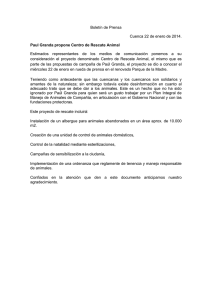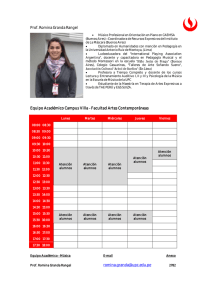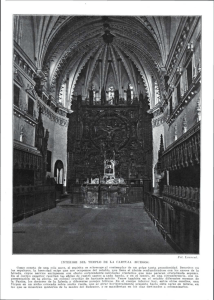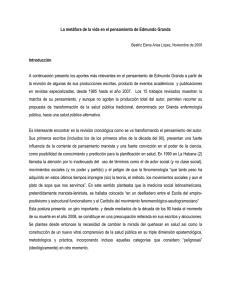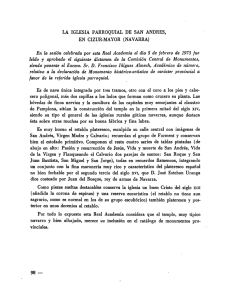Talla e imaginería Sculpture and statuary
Anuncio
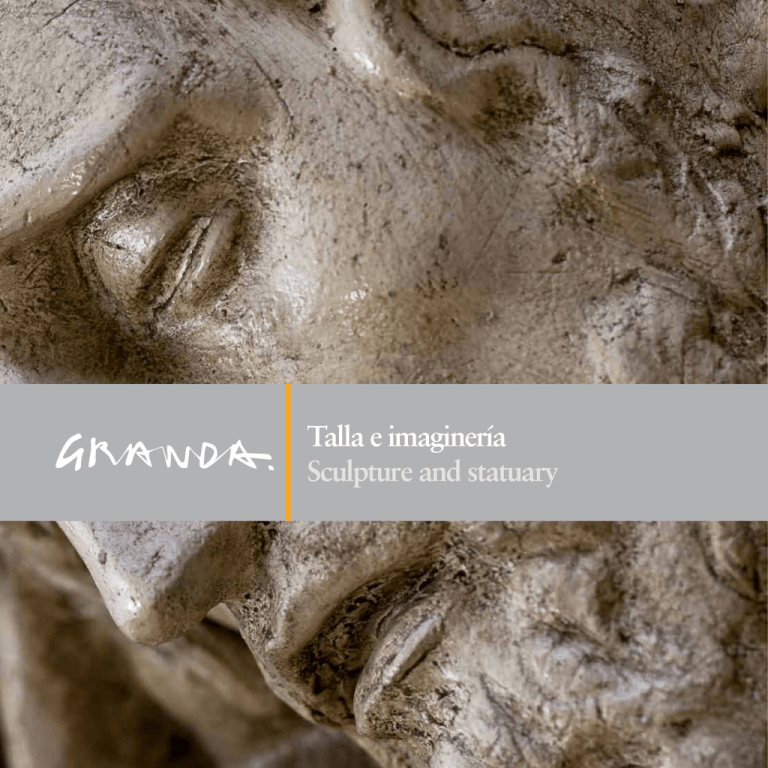
Talla e imaginería Sculpture and statuary Presentación | Presentation 1. Presentación | Presentation . . . . . . . . . . . . . . . . . . . . . . . . . . . . . . . . . . . . . . . . . . . 1 2. Técnicas artesanales | Artisanal techniques. . . . . . . . . . . . . . . . . . . . . . . . . . . 2 3. Policromía, dorado y estofado | Polychromy, gilding and “estofado”. . . 4 4. Materiales y calidades | Materials and qualities. . . . . . . . . . . . . . . . . . . . . . 5 5. Retablos y pasos procesionales | Altarpieces and processional floats. . . . 8 6. Retablo de San Juan de Capistrano | San Juan Capistrano altarpiece. . 10 A lo largo de sus más de ciento veinte años de historia, han pasado por los Talleres de Arte de Granda numerosos escultores e imagineros de renombre, que realizaron en ellos algunas de sus mejores obras y dejaron para siempre su impronta, formando a varias generaciones de aprendices. José Capuz, Frechilla, Vicent, Ortega Bru, Núñez-Ladevèze, son algunos de los nombres más destacados que han trabajado o colaborado con Granda desde el inicio, velando, con su saber hacer y su amor por el detalle y la perfección, obras perfectamente adecuadas para el culto como tallas y retablos. Catedrales, iglesias, capillas y oratorios están revestidos por nuestras obras, creadas desde la humildad que de forma anónima evoca, tal y como deseaba don Félix Granda, los talleres medievales, en los que el nombre del autor era insignificante comparado con la finalidad a la que estaba destinada la obra: la representación plástica de los misterios religiosos. D. Francisco G. Olmedo Vicepresidente Ejecutivo de GRANDA Throughout the more than 120 years of its history, numerous wellknown sculptors and image-makers have passed through Talleres de Arte Granda, the sacred art workshops where they have produced some of their best works and left their mark for all time, training several generations of apprentices. José Capuz, Frechilla, Vicent, Ortega Bru and Núñez-Ladevèze are just some of the finest artists who have worked and collaborated with Granda since its beginnings, helping to create with their skills and search for perfection works of arts, such as altarpieces and statues, ideally suited for worship. These works, created out of humility and anonymously, emulating medieval workshops where the artist’s name was insignificant compared with the sacred art’s purpose: the plastic representation of religious mysteries, as was Felix Granda’s desire, now decorate cathedrals, churches, chapels and oratories. Mr. Francisco G. Olmedo Executive Vice-President of GRANDA Talla e imaginería | Sculpture and statuary | 1 Técnicas artesanales | Artisanal techniques Desde tiempos remotos, el hombre ha tenido la necesidad de dar forma a la materia. Al principio lo hizo con los materiales más simples que tenía a mano: piedra, arcilla y madera. Después pasó a emplear materiales más nobles, que garantizasen la perdurabilidad de su creación, como hierro, bronce, plomo, cera, yeso, resina de poliéster y plásticos con refuerzo de fibra de vidrio, hormigón, llegando a emplear elementos virtuales como la cinética y la reflexión de la luz, entre otros. Since the remotest times, man has felt the need to give shape to materials. In the beginning, this was done with the simple materials at hand: stone, clay and wood. Later more noble materials were used, such as iron, bronze, lead, wax and plaster, guaranteeing the long-lasting nature of his creations. Later came polyester resins, fibreglass-reinforced plastics and concrete and, most recently, virtual elements, such as kinetics and light reflection. Lo que en principio fue sólo una forma de expresión artística del escultor creando volúmenes y conformando espacios, para el Cristianismo se convirtió, desde los primeros siglos, en una forma de representar, de una manera plástica, los misterios de la fe. Será con el arte Románico y Gótico (siglos XII-XV) donde comience la evolución de la escultura en madera o imaginería, con fin catequético, que se desarrollará extraordinariamente durante el periodo barroco en el área mediterránea y en particular en España. What at first was merely the sculptor’s artistic expression, creating volumes and confining spaces, for the Christian world of the early centuries it became a manner of representing the mysteries of the faith. Romanesque and Gothic art of the 12th to 15th centuries saw the commencement of the evolution in wood sculptures and statuary for catechetical purposes, with extraordinary development during the Baroque period in the Mediterranean basin and Spain in particular. La escultura religiosa de la época barroca, la imaginería policromada, es la que, aún hoy en día, sigue inspirando a los artesanos y artistas de GRANDA. La temática tratada es exclusivamente religiosa. Es una escultura con gran sentido del movimiento, tensión y energía; con una composición asimétrica con predominio de las diagonales, de los escorzos y fuertes contrastes de luces y sombras que realzan los efectos escenográficos y el naturalismo de las imágenes. Guiados por el sentido de la creación de nuestros artistas, las figuras que se elaboran no son la simple repetición de un estereotipo, sino que realizan las imágenes de forma individualizada e irrepetible, dotándolas de personalidad propia. Nuestros artistas insuflan en cada una de ellas la representación de los sentimientos interiores, reflejando en los rostros de las figuras las pasiones que encarnan cada uno de los personajes representados. La finalidad buscada con este tipo de escultura es promover la emoción y evocar el sentimiento. Cuando el artesano aborda la tarea de crear una imagen, dispone de un amplio abanico de recursos expresivos, que garanticen su embellecimiento, estos van desde la sencilla madera tallada, hasta las complejas y elaboradas técnicas que implica el estofado. La técnica más habitual empleada en GRANDA es la talla en madera policromada, pues con esta técnica se garantiza el realismo más convincente y el color acentúa ese realismo de lo representado, dotándolo de una apariencia más naturalista. 2 | Talla e imaginería | Sculpture and statuary The religious sculpture of the Baroque period, polychromatic imagery, continues to inspire GRANDA artists and artisans even today. The subject matter is exclusively religious. Sculptures with a strong sense of movement, tension and energy; asymetric composition with a predominance of diagonals, foreshortening and stark contrasts between light and shadow, highlighting the images’ naturalism and scenographic effects. Guided by the artists’ creative sensibility, these figures are no mere repetition of a stereotype but individual and unrepeatable images, endowed with their own personality. Our artists breath into each statue the representation of their own inner feelings, reflecting in the statues’ faces the passions felt by each one of the characters represented. The aim being sought with this type of sculpture is to arouse feelings and promote emotions. The GRANDA artisans, as an expressive language, avoid representations of exaggerated realism that, instead of awakening pity, provoke rejection. With profound dynamism and highly expressive miens, they seek beauty without rejecting spiritual content. When a craftsman tackles the task of creating a statue, he has a wide range of expressive resources available to him to guarantee its embellishment, from simple carved wood to the complex and elaborate “estofado” techniques. The technique most widely used in GRANDA is carved and polychromed wood which guarantees the most convincing realism accentuated by colour, endowing the statue with a more natural appearance. Policromía, dorado y estofado | Polychromy, gilding and “estofado” La policromía puede conseguirse combinando materiales de distintos colores en una misma escultura o pintando la superficie de la escultura. El procedimiento más sencillo es aplicar los colores directamente sobre la superficie. Se emplean colores disueltos al temple o a la cera que después se pueden barnizar. La policromía no sólo se aplica a la imaginaria. Esta técnica permite simular cualquier tipo de acabado sobre madera, creando bellos trampantojos, es especialmente destacable la pericia que han alcanzado nuestros artesanos en los acabados marmolados. El dorado es una compleja técnica decorativa que permite simular el acabado en metales nobles de las piezas talladas en madera, o dar brillo a las pinturas que se aplican encima. El estofado consiste en pintar sobre los elementos dorados de la talla, con distintos colores en las telas o adornos. Antes de que los colores se sequen por completo, se realizan dibujos mediante pequeñas puntas de madera blanda con las que se rasca la pintura para que aparezca el dorado o el plateado de la capa inferior. Esta complicada técnica, trata de imitar en escultura los tejidos con brocado de hilos de oro y plata. Polychromy can be achieved through a combination of different coloured materials in the same statue or by painting the statue’s surface. The simplest polychrome procedure is to apply the different colours directly onto the natural or polished wood. Soft tempera or wax-based colours that can then be varnished are used. Polychrome is not only applied to statuary, however. This technique allows any type of finish to be simulated on wood, leading to the creation of beatiful trompe-l’oeil pieces. Particularly worthy of note is the skill achieved by our artisans in the creation of faux marble finishes. Gilding is a complex decorative technique used to give carved wood pieces a simulated gold or silver finish or to give a special shine to the paintings applied on top. “Estofado”, a traditional Spanish technique, consists in painting over the statue’s gilded elements, particularly clothing and embellishments, with different colours. Before the colours dry completely, the artist etches intricate patterns in the colourful painted surface using small softwood punches, with which the paint is scratched away to reveal the lower surface’s gilding. This complicated technique aims to imitate in sculpture brocade cloth with gold and silver threads. 4 | Talla e imaginería | Sculpture and statuary Materiales y calidades | Materials and qualities La madera es el material en el que GRANDA desarrolla sus máximas capacidades artísticas, creando sus obras de mayor formato, los retablos y los pasos procesionales. Wood is the material in which GRANDA develops its maximum artistic capabilities, creating large-format works, i.e. altarpieces and processional floats. La madera empleada es maciza, principalmente de cedro o tilo, en función de las condiciones ambientales del lugar al que está destinada. Se somete a tratamientos especiales ignífugos, antiparásitos o antihumedad, para adecuarse a los espacios en que las imágenes serán emplazadas. The wood used in the statues is solid, mainly cedar and lime, depending on the environmental conditions of the place of destination. When necessary, the wood is subjected to special treatments to protect it against fire, insects and moisture, in order to adapt it to the spaces in which the statues are to be placed. Fieles a nuestro compromiso con la excelencia, e implicados en la lucha por la preservación del medio ambiente, cuidamos de que nuestras maderas procedan de bosques sostenibles y dispongan de las certificaciones ecológicas pertinentes. True to our commitment to quality and excellence, and fully involved in the fight for the conservation of the environment, we take special care to ensure that the wood we use comes from sustainable forests and has all the appropriate environmental certificates. En nuestras piezas, también se emplean los pigmentos y colas que se han utilizado en la tradición de la artesanía imaginera española. Los dorados se efectúan con oro de 24 kilates. The pigments and glues traditionally used in Spanish statuary craftsmanship are still being used today. Gilding is carried out with 24 carat gold leaf. Talla e imaginería | Sculpture and statuary | 5 Retablos y pasos procesionales | Altarpieces and processional floats Desde el Renacimiento, la Iglesia Católica aceptó el canon de belleza grecolatino, que caracterizara desde este momento a la imaginería religiosa. Uno de los elementos más importantes de este concepto de representación es la creación de estereotipos que identifican a los diferentes santos del orbe cristiano, así como la riqueza de sus hagiografías, permitiendo los creyentes la comprensión de todo el mensaje iconográfico. Esta forma de representación simbólica consigue su mayor representatividad en las fachadas de los templos románicos y góticos, donde arquivoltas, capiteles y jambas se constituirán como verdaderas biblias petreas. Posteriormente, los retablos renacentistas alcanzarán, con sus elaborados discursos iconográficos, una complejidad narrativa casi cinematográfica. Los retablos y los pasos procesionales son obras de gran complejidad en las que es necesaria la participación de todos los oficios que existen en GRANDA. Los ebanistas y carpinteros, que realizan la estructura; los tallistas, policromadores, doradores, cuyas gubias y pinceles dan expresión humana a las imágenes; los orfebres, que ejecutan las coronas, y embellecen los tronos, las costureras y bordadoras que confeccionan los ropajes que visten las figuras, y sus decoraciones primorosas aportan, en estas grandes obras, lo mejor de sí. Starting in the Renaissance, the Catholic church accepted the GrecoRoman canon of beauty, which was to characterize religious imagery from that time. One of the most important elements of this concept of representation is the creation of stereotypes that symbolize the different saints of the Christian world and the richness of their hagiographies, allowing believers to capture the full iconographic message. This form of symbolic representation achieves its greatest representation on the facades of Romanesque and Gothic temples, where archivolts, capitals and door-jambs became veritable stone bibles. Subsequently, Renaissance altarpieces, with their elaborate iconographic discourse, were to achieve an almost cinematographic narrative complexity. Altarpieces as well as processional floats are works of art of considerable complexity requiring the participation of all the crafts represented in GRANDA. Cabinetmakers and carpenters for the structure; carvers, polychome artists and gilders, whose gouges and brushes give the images human expression; goldsmiths who execute the crowns and embellish the thrones; and seamstresses and embroiderers who prepare the vestments with which the figures are dressed and the exquisite decorations that so frequently embellish the figures, all give of their best to make these major works of art what they are. 8 | Talla e imaginería | Sculpture and statuary Detalle del retablo que se encuentra en la Parroquia del Espíritu Santo y Nuestra Señora de la Araucana (Madrid, 2011). Representa Pentecostés. Detailed view of the altarpiece, representing Pentecost,which can be found at the Parish of the Holy Spirit and Our Lady of Araucana (Madrid, 2011). Retablo de San Juan de Capistrano | San Juan Capistrano “retablo” Dimensiones Materiales Dimensions Materials 14 x 9 m. Madera de cedro de Brasil, acero, estuco, láminas de oro de 24 quilates, latón pigmento. 14 x 9 m. Brazil cedar wood, steel, stucco, 24 carat gold leaf, brass, pigments. Técnicas Techniques Carpintería, ensamblado, escultura, talla, estofado, dorado, policromía, pintura sobre lienzo y cincelado. Carpentry, wood carving, polychromy, “estofado”, gilding, oil on canvas painting and chiseling. Iconografía Iconography El retablo es signo de la Evangelización que llevaron a cabo las misiones en California siendo el elemento central la Santísima Trinidad que recoge el momento de la entrega del Padre al Hijo por la redención de los hombres guiada por la acción del Espíritu Santo. En la base se encuentra el lienzo de la Virgen coronada en su advocación de Guadalupe. En la parte superior de la calle izquierda aparece Fray Junípero Serra, fundador de misiones. En la parte inferior y a la altura de la Virgen, se encuentra San José con la vara florida mientras que en el lado superior derecho aparece Santa Catalina de Tekakwitha, primera santa originaria de América del Norte y en la parte inferior, aparece San Francisco de Asís, a cuya orden pertenecen los primeros evangelizadores. El retablo se articula a través de columnas salomónicas decoradas con pámpanos y racimos de uvas, símbolos de la Eucaristía. Como peculiaridad, setenta golondrinas, posadas sobre las columnas, hacer referencia a un hecho singular que acontece en esta ciudad. The retablo symbolizes the Evangelization carried out in the California Missions. Its main theme is the Most Holy Trinity, which captures the instant of giving of the Son by the Father for the redemption of mankind, guided by the action of the Holy Spirit. At the base of the retablo is the canvass of the Crowned Virgin under the title of Our Lady of Guadalupe. At the top of the left aisle appears Fray Junípero Serra, founder of missions. At the bottom of the same aisle, is found St Joseph with the flowering staff. In the right aisle, St Catherine Tekakwitha, the first beatified Native American.At the bottom appears St Francis Assisi, whose Order the first evangelizers of the Mission belonged. The altarpiece is sustained by Solomonic columns decorated with vines and bunches of grapes, symbols of the Eucharist. As note of interest, seventy swallowsposed over the columns refers to a singular fact that occurs in this city. Reasoned classification Clasificación razonada Retablo en estilo barroco según las características del arte colonial español de la segunda mitad del s XVIII. Se trata de una réplica del original destruido por un terremoto en 1812 y realizado por artesanos mayorquines. El retablo viste la Nave principal de la capilla de la misión de San Juan de Capistrano. La construcción del templo fue iniciada en 1797 y concluida en1806. En 1833 las misiones californianas fueron secularizadas y fue vendido a propietarios privados en 1845. La Misión fue restablecida al culto católico en 1865. En los últimos años se inicia un proceso de recuperación del templo que culmina con la colocación de esta réplica del retablo elaborada por GRANDA en su situación original. Es de destacar la inclusión de la primera beata indígena americana Beata Catalina Tekakwitha, nacida en 1657 en Aurieville, Nueva York. 10 | Talla e imaginería | Sculpture and statuary Retablo in the High Baroque style, following the characteristics of eighteenth century Spanish colonial art. It is a replica of the original destroyed in the earthquake of 1812. The retablo decorates the main nave of the chapel at Mission San Juan Capistrano. Work started on the “Great Stone Church” in 1797 and was completed in 1806. In 1833 an Act was passed for the Secularization of the Missions of California and their property was sold to private buyers in 1845. The Mission’s worship was restored to the Roman Catholic Church in 1865. In recent years, a process of recovery has been initiated on the basilica, culminating in the installation in its original position of this replica of the altarpiece or retablo prepared by GRANDA. Worthy of note is the inclusion amongst the imagery of the first Native American religious laywoman, Catherine Tekakwitha, born around 1657 near Auriesville, New York. “Usar el arte como usamos el lenguaje, para hablar y enseñar a Cristo, y no para enseñarnos a nosotros mismos, y mucho menos para hacer alarde de nuestro lujo y vanidad” D. Félix Granda Buylla Talleres de Arte, Madrid, 1911 “To use art as we use language, to talk and to present Christ, and not to present ourselves, and even less to show off our luxury an vanity” Fr. Félix Granda Buylla Talleres de Arte, Madrid, 1911 w w w . g r a n d a . c o m Pasión, Excelencia, Arte
